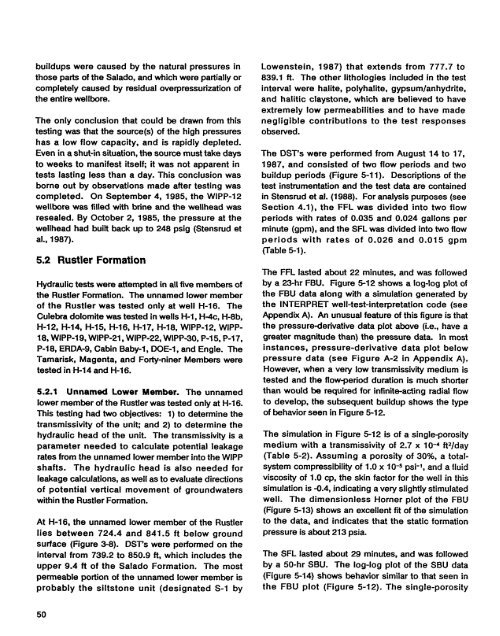Beauheim 1987 - Waste Isolation Pilot Plant - U.S. Department of ...
Beauheim 1987 - Waste Isolation Pilot Plant - U.S. Department of ...
Beauheim 1987 - Waste Isolation Pilot Plant - U.S. Department of ...
You also want an ePaper? Increase the reach of your titles
YUMPU automatically turns print PDFs into web optimized ePapers that Google loves.
uildups were caused by the natural pressures in<br />
those parts <strong>of</strong> the Salado, and which were partially or<br />
completely caused by residual overpressurization <strong>of</strong><br />
the entire wellbore.<br />
The only conclusion that could be drawn from this<br />
testing was that the source(s) <strong>of</strong> the high pressures<br />
has a low flow capacity, and is rapidly depleted.<br />
Even in a shut-in situation, the source must take days<br />
to weeks to manifest itself; it was not apparent in<br />
tests lasting less than a day. This conclusion was<br />
borne out by observations made after testing was<br />
completed. On September 4, 1985, the WIPP-12<br />
wellbore was filled with brine and the wellhead was<br />
resealed. By October 2, 1985, the pressure at the<br />
wellhead had built back up to 248 psig (Stensrud et<br />
al., <strong>1987</strong>).<br />
5.2 Rustler Formation<br />
Hydraulic tests were attempted in all five members <strong>of</strong><br />
the Rustler Formation. The unnamed lower member<br />
<strong>of</strong> the Rustler was tested only at well H-16. The<br />
Culebra dolomite was tested in wells H-1 , H-4c1 H-8b,<br />
H-12, H-14, H-15, H-16, H-17, H-18, WIPP-12, WIPP-<br />
18, WIPP-19, WIPP-21, WIPP-22, WIPP-30, P-l5, P-17,<br />
P-18, ERDA-9, Cabin Baby-1, DOE-1 , and Engle. The<br />
Tamarisk, Magenta, and Forty-niner Members were<br />
tested in H-14 and H-16.<br />
5.2.1 Unnamed Lower Member. The unnamed<br />
lower member <strong>of</strong> the Rustler was tested only at H-16.<br />
This testing had two objectives: 1) to determine the<br />
transmissivity <strong>of</strong> the unit; and 2) to determine the<br />
hydraulic head <strong>of</strong> the unit. The transmissivity is a<br />
parameter needed to calculate potential leakage<br />
rates from the unnamed lower member into the WlPP<br />
shafts. The hydraulic head is also needed for<br />
leakage calculations, as well as to evaluate directions<br />
<strong>of</strong> potential vertical movement <strong>of</strong> groundwaters<br />
within the Rustler Formation.<br />
At H-16, the unnamed lower member <strong>of</strong> the Rustler<br />
lies between 724.4 and 841.5 ft below ground<br />
surface (Figure 3-8). DSTs were performed on the<br />
interval from 739.2 to 850.9 ft, which includes the<br />
upper 9.4 ft <strong>of</strong> the Salado Formation. The most<br />
permeable portion <strong>of</strong> the unnamed lower member is<br />
probably the siltstone unit (designated S-1 by<br />
Lowenstein, <strong>1987</strong>) that extends from 777.7 to<br />
839.1 ft. The other lithologies included in the test<br />
interval were halite, polyhalite, gypsumlanhydrite,<br />
and halitic claystone, which are believed to have<br />
extremely low permeabilities and to have made<br />
negligible contributions to the test responses<br />
observed.<br />
The DST's were performed from August 14 to 17,<br />
<strong>1987</strong>, and consisted <strong>of</strong> two flow periods and two<br />
buildup periods (Figure 5-1 1). Descriptions <strong>of</strong> the<br />
test instrumentation and the test data are contained<br />
in Stensrud et at. (1988). For analysis purposes (see<br />
Section 4.1), the FFL was divided into two flow<br />
periods with rates <strong>of</strong> 0.035 and 0.024 gallons per<br />
minute (gpm), and the SFL was divided into two flow<br />
periods with rates <strong>of</strong> 0.026 and 0.015 gpm<br />
(Table 5-1).<br />
The FFL lasted about 22 minutes, and was followed<br />
by a 23-hr FEU. Figure 5-12 shows a log-log plot <strong>of</strong><br />
the FBU data along with a simulation generated by<br />
the INTERPRET' well-test-interpretation code (see<br />
Appendix A). An unusual feature <strong>of</strong> this figure is that<br />
the pressure-derivative data plot above (Le., have a<br />
greater magnitude than) the pressure data. In most<br />
instances, pressure-derivative data plot below<br />
pressure data (see Figure A-2 in Appendix A).<br />
However, when a very low transmissivity medium is<br />
tested and the flow-period duration is much shorter<br />
than would be required for infinite-acting radial flow<br />
to develop, the subsequent buildup shows the type<br />
<strong>of</strong> behavior seen in Figure 5-12.<br />
The simulation in Figure 5-12 is <strong>of</strong> a single-porosity<br />
medium with a transmissivity <strong>of</strong> 2.7 x 10' ftZfday<br />
(Table 5-2). Assuming a porosity <strong>of</strong> 30%, a totalsystem<br />
compressibility <strong>of</strong> 1 .O x 10-5 psi-', and a fluid<br />
viscosity <strong>of</strong> 1.0 cp, the skin factor for the well in this<br />
simulation is -0.4, indicating a very slightly stimulated<br />
well. The dimensionless Horner plot <strong>of</strong> the FBU<br />
(Figure 5-13) shows an excellent fit <strong>of</strong> the simulation<br />
to the data, and indicates that the static formation<br />
pressure is about 213 psia.<br />
The SFL lasted about 29 minutes, and was followed<br />
by a 50-hr SBU. The log-log plot <strong>of</strong> the SBU data<br />
(Figure 5-14) shows behavior similar to that seen in<br />
the FBU plot (Figure 5-12). The single-porosity<br />
50

















